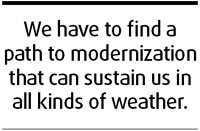Two snow crises, one central challenge
Updated: 2008-02-05 07:29
It so happens that while we in China are mobilized to fight the worst snow disaster in memory, many people in the United States are commemorating the 30th anniversary of another snow crisis.

Going down in history as the "Great Blizzard of 1978", the "white hurricane" that swept North America in late January and early February 30 years ago left many Americans with no power, no heat, and no transportation for days or weeks on end. People were trapped in their houses or offices or on roads. A state of emergency was declared in several states, and National Guard troops were called in to aid stranded people on highways.
Many Americans who lived through the blizzard have never forgotten it, nor will their Chinese counterparts forget their snow disaster 30 years later.
Statistics show that the 1978 blizzard caused $500 million in damages to Massachusetts alone. It is not yet known how much the ongoing snow disaster will cost China, but it is certain we will be hit harder since it struck right in the middle of the peak travel time for the country's most important festival. And the snowstorms have hit parts of the country where such weather is rare.
It would be pointless to compare which of the snow disasters has been more disruptive. What is noteworthy is the similarity of the challenges posed by the two crises, though they are separated by three decades.
Many agree that the recent snowstorms highlight the vulnerability of China's booming economy. It is obvious that the extreme weather caught the Chinese government and people unprepared and worsened problems such as the shortage of power, traffic congestion and inflation.
Similar scenarios were witnessed during the Great Blizzard of 1978. People who experienced that crisis vividly recall years later that there were no deliveries of food, milk and newspapers, among other things. Some food items were rationed. In disaster areas, many people were left without heat, water, food and electricity for more than a week after the storm finished. Schools were closed for weeks.
Yet even 30 years back, the United States, as a well-developed superpower, was far better off than China is today. And the northern US states hit by the blizzard were better equipped to handle ice and snow than the southern Chinese provinces in the current snow crisis.
Nevertheless, as Thomas Schmidlin, a weather historian and professor of geography at Kent State University, remarked 25 years after the 1978 blizzard: "With our comforts of cars, electricity and heating, we may actually be more vulnerable to these blizzards than Ohioans of the 19th century, who were more independent and could tolerate disruptions of a few days."
This is perhaps inconveniently true in both countries. Although we are at varying levels of development, we seem equally impotent in the face of natural disasters. We are both handicapped when our modern infrastructure is left paralyzed by the extremes of nature.
Yes, people in southern China are fighting the snow disaster heroically. The best we can do, however, is to minimize the damage rather than immunize ourselves from such hits. Even if the country's infrastructure is improved after the snow crisis, we will not be able to guarantee that expressways will not be shut down, flights not be canceled or delayed and railways not affected when we have another bout of nasty weather.
If the modernity we rely on so heavily is so vulnerable to natural elements, should we not be asking ourselves whether such reliance is reasonable? It is a nightmare when electricity is your only means of making heat, but the coal used to make power cannot be delivered.
Of course we should not go back to primitive times to avoid the blows of extreme weather. But it would really be disastrous if we completely lacked alternatives when our main transport and communication networks were affected by bad weather.
Maybe we should take some inspiration from the role played by internal combustion locomotives during the current snow disaster. When the power failure paralyzed electric locomotives, internal combustion locomotives served as "ferry engines" to drive the trains out of their tight spots.
In normal times, everyone would consider the electric locomotive "more advanced" than its internal combustion counterpart. Now we know we are mistaken.
The crises in the United States 30 years ago and the one unfolding now in China send a similar warning: The modernization in which we indulge may not be as powerful as it looks. We have to find a path to modernization that can sustain us in all kinds of weather. The modernization we need should improve our capacity to cope with a snow disaster like the one we have now, rather than just help us when it comes time to clean up afterwards.
The author is a council member of the China Society for Human Rights Studies
(China Daily 02/05/2008 page8)
|
|
|
|
|
|